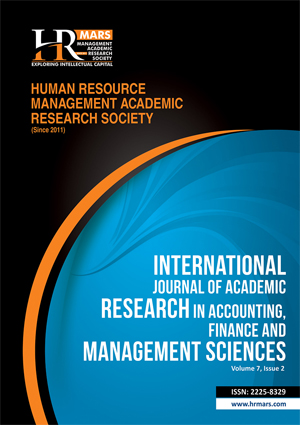
ISSN: 2225-8329
Open access
This study examines the effect of macroeconomic variables on stock prices in Ghana. Analysis was done using monthly data from 1991.4 to 2010.8. This study employed cointegration test and vector error correction models (VECM) to examine both long-run and short-run dynamic relationships between the stock market index and the macroeconomic variables. Generalized impulse function (IRF) and forecast error variance decomposition (FEVD) were used to detect the effect of shocks in the macroeconomic factors on complete time path of stock prices and vice versa. The time series properties of the data were, first, analyzed using the Augmented Dickey-Fuller (ADF) and Phillips-Perron tests. The empirical results derived indicate that all the variables were stationary after their first differencing. The paper established that there is cointegration between macroeconomic variables and Stock prices in Ghana indicating long run relationship. The above long term relation indicates that Interest Rate (TB) and Exchange Rate (XR) have a negative effect on Stock Prices whiles Inflation (CPI) showed a positive effect on Stock Prices (DSI). Results of Impulse Response Function (IRF) and Forecast Error Variance Decomposition (FEVD) indicate that the macroeconomic variables identified a low significant influence on share price movements in Ghana.
Adam, M. A., and Tweneboah, G. (2008), “Macroeconomic Factors and Stock Market Movement: Evidence from Ghana”, MPRA Paper No. 11256.
Adjasi, C., Harvey, S. K., and Agyapong, D. (2008), “Effect Of Exchange Rate Volatility on the Ghana Stock Exchange”, African Journal of Accounting, Economics, Finance and Banking Research Vol. 3. No. 3. 2008.
Al-Sharkas, A. (2004), “The Dynamic Relationship between Macroeconomic Factors and the Jordanian stock market”, International Journal of Applied Econometrics and Quantitative Studies, pp. 97-114
Aydemir, O., and Demirhan, E. (2009), “The Relationship between Stock Prices and Exchange Rates Evidence from Turkey”, International Research Journal of Finance and Economics, 23,207-215.
Binswanger, M. (2000), “Stock returns and real activity: Is there still a connection”? Applied Financial Economics, 10(4), 379-387.
Brahmasrene, T., and Jiranyakul, K. (2007), “Cointegration and Causality between stock index and macroeconomic variables in an emerging market”, Academy of Accounting and Financial Studies Journal, 11(3), 17-30.
Chen, N. F., Roll, R., and Ross, S. A. (1986), “Economic Forces and the Stock Market”, Journal of Business 59, 383-403.
Choi, D., and Jen, F. C. (1991), “The Relation between Stock Returns and Short-Term Interest Rates. Review of Quantitative Finance and Accounting, Vol. 1, pp. 75-89
Flannery, M. J., and Protopapadakis, A. A. (2001), Macroeconomic Factors Do Influence Aggregate Stock Returns. Journal of Finance 53, 32-57
Foresti, P. (2006), Testing for Granger causality between stock prices and economic growth, MPRA Paper No. 2962.
Gjerde, O., and Saettem, F. (1999), Casual Relations among Stock Returns and Macroeconomic Variables in a Small, Open Economy. Journal of International Finance Markets Institutions and Money, 9, 61-74.
Granger, C. W. J., and Newbold, P. (1974), Spurious regressions in econometrics. Journal of Econometrics , 2, 111-120
Gultekin, N. B. (1983), Stock market returns and inflation: evidence from other countries. Journal of Finance 38, 49-65.
Hoguet, G. R. (2008), Inflation and Stock Price.State Street Global Advisors
Johansen, S. (1991), Estimation and Hypothesis Testing of Cointegrating Vectors in Gaussian Vector Autoregressive Models, Econometrica 59, 1551-1580.
Johansen, S. (1995), Likelihood based Inference in Cointegrated Vector Auto-Regressive Models, Oxford University Press.
Kandir, S. Y. (2008), Macroeconomic Variables, Firm Characteristics and Stock Returns: Evidence from Turkey. International Research Journal of Finance and Economics.
Maghayereh, A. (2002), Causal Relations among Stock Prices and Macroeconomic Variables in the Small, Open Economy of Jordan. Journal of Finance 37.
Maysami, R. C., and Koh, T. S. (2000), A Vector Error Correction Model of the Singapore Stock Market. International Review of Economics and Finance 9, 79 – 96.
Naka, A., Mukherjee, T. (1995), Macroeconomic Variables and the Performance of the Indian Stock Market: University of New Orleans, Department of Economics and Finance Working Paper No. 203
Poon, S., and Taylor, S. J. (1991), Macroeconomic Factors and the UK Stock Market. Journal of Business and Accounting, 18, 619-636.
Ross, S. A. (1976), The Arbitrage Theory of Capital Asset Pricing, Journal of Economic Theory, 13, 341-360.
In-Text Citation: (Mireku et al., 2013)
To Cite this Article: Mireku, K., Sarkodie, K., & Poku, K. (2013). Effect of Macroeconomic Factors on Stock Prices in Ghana: A Vector Error Correction Model Approach. International Journal of Academic Research in Accounting Finance and Management Sciences, 3(2), 39–53.
Copyright: © 2021 The Author(s)
Published by HRMARS (www.hrmars.com)
This article is published under the Creative Commons Attribution (CC BY 4.0) license. Anyone may reproduce, distribute, translate and create derivative works of this article (for both commercial and non-commercial purposes), subject to full attribution to the original publication and authors. The full terms of this license may be seen at: http://creativecommons.org/licences/by/4.0/legalcode